An Authoritative Guide to Unlocking Timeless Elegance
Table of Contents
Toggle- An Authoritative Guide to Unlocking Timeless Elegance
- Unlocking the Enduring Charm of Grey Marble
- Part I: What is Gray Marble Called? An Authoritative Guide
- Part II: Beyond Grey: Understanding the Full Spectrum of Marble
- Part III: From Quarry to Countertop: The Commercial Side
- Part IV: Industry Focus: Trends, Data, and Sustainability
- Part V: Practical Applications and Expert Care
- Conclusion: The Enduring Legacy of Grey Marble
- FAQ: Google Hot Search Q&A
- Unlocking the Value of Grey Marble in Modern Design and Industry
Unlocking the Enduring Charm of Grey Marble
Grey marble, as a powerful natural stone, imbues any environment with a unique charm through its inherent sophistication, tranquility, and timeless qualities. Far from being a cold material, it blends perfectly with beige, brown, or wood tones to create a warm and comfortable atmosphere.1 From Nordic and industrial to rustic styles, the versatility of grey marble allows it to effortlessly complement various high-caliber design aesthetics.1 This in-depth blog post will move beyond simple naming to explore the scientific origins of grey marble, its popular varieties, global market dynamics, and its central role in modern design and the wave of sustainability.
Part I: What is Gray Marble Called? An Authoritative Guide
The Geological Palette: The Science Behind the Shades
Marble is a metamorphic rock formed from limestone or dolomite rock that has undergone extreme heat and pressure deep within the Earth.3 Its final color is not an inherent property of the stone but a direct result of the mineral impurities present during its formation.2 For example, the common colors of marble—including white, red, black, grey, pink, and green—are all derived from the presence of different impurities.
Specifically, the formation of grey and black colors is primarily attributed to fine scales of graphite.2 Other minerals like iron oxides and pyrite can also cause specific color variations.2 For instance, green is typically caused by green pyroxene and amphibole, brown by garnet and vesuvianite, and yellow by epidote, chondrodite, and titanite.
This geological process explains why grey marble can present such a rich spectrum of colors, from light silver-grey to deep charcoal. The unique textures and tonal variations on each slab directly reflect the specific geological conditions it was subjected to during metamorphosis. This provides designers with an almost limitless palette, allowing them to choose grey marble of different shades and textures to achieve subtle balance or strong contrast, depending on the needs of the space. This direct link from science to aesthetics is the fundamental reason why grey marble is widely used and highly favored in modern design.
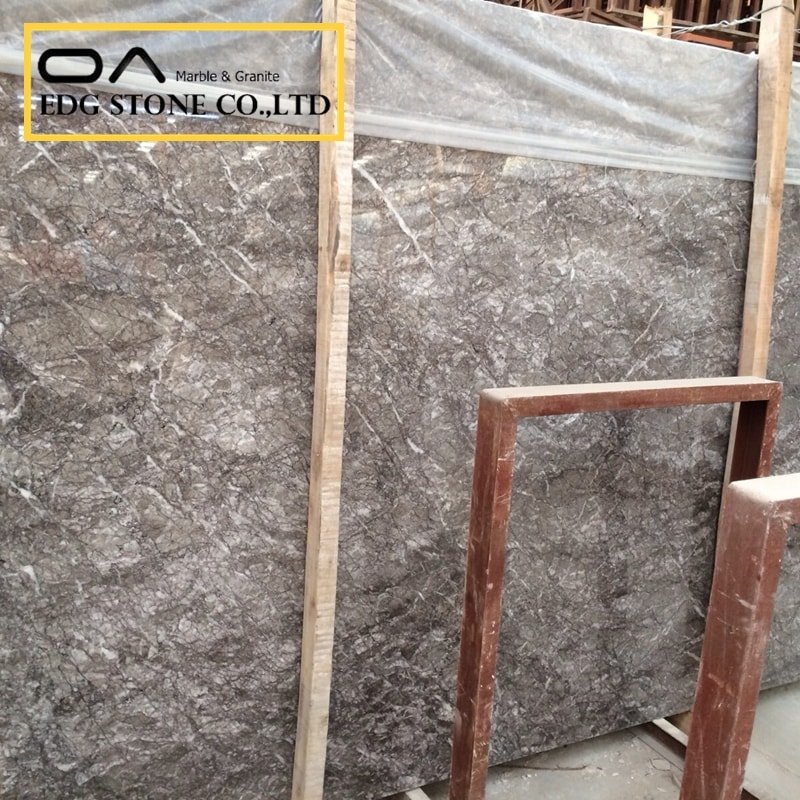
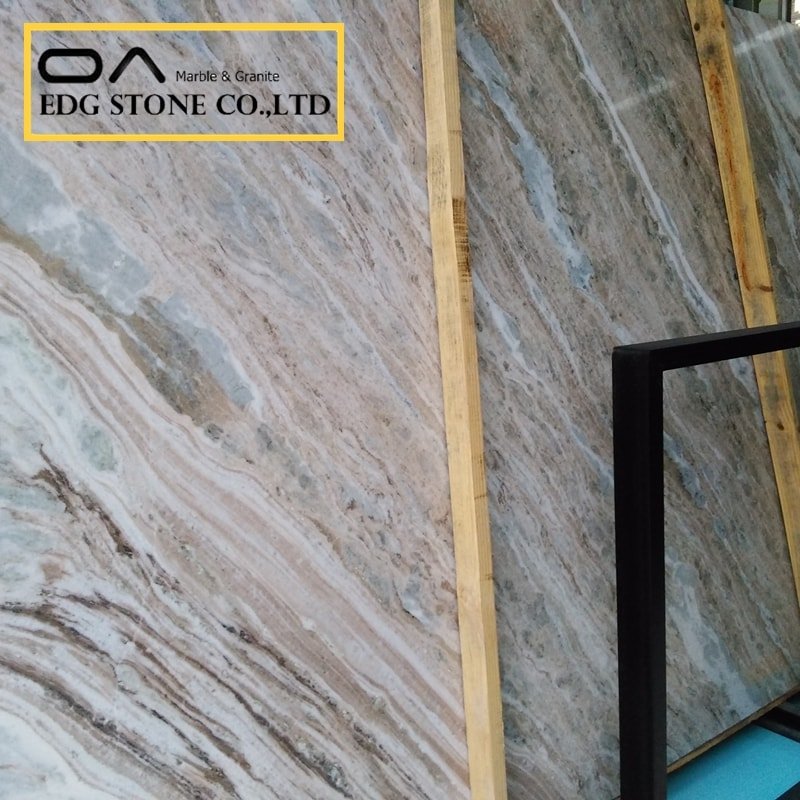
The Composition of Grey Marble: Understanding Veining and Finishes
Marble’s most prominent visual feature is its unique veining, which is formed by the recrystallization of mineral-rich fissures during the metamorphic process.2 These veins give each marble slab a unique personality, much like a fingerprint, as no two are exactly alike.2 In addition to natural veining, the stone’s surface finish also plays a decisive role in its aesthetics and functional application.
- Polished: The surface of polished marble is smooth, highly reflective, and capable of reflecting light intensely.5 This finish maximizes the contrast of the marble’s veining and is therefore often used for countertops and accent walls.
- Honed: Honed marble has a smooth but non-reflective surface, presenting an elegant, matte effect.6 This finish not only reduces the appearance of scratches and fingerprints under light but also lowers the risk of slipping on floors, making it an ideal choice for high-traffic areas and flooring.
- Leathered/Brushed: This finish is achieved by using diamond-tipped brushes to give the marble surface a textured feel.2 It offers both the non-slip properties of a honed finish and the ability to hide fingerprints, making it popular for outdoor applications, patios, and countertops.
Famous Varieties: Exploring Globally Popular Grey Marbles
There are numerous varieties of grey marble, many of which are renowned for their distinctive appearance or origin. The following are some of the most commercially popular and aesthetically representative varieties:
- Pietra Grey: This is a dark charcoal or black marble from Iran, known for its striking white veining.2 Locally, it is called Lashator marble 6 and is often used in modern and minimalist spaces due to its elegant and understated color.2 It also has medium hardness and weather resistance, making it suitable for interior and exterior walls, countertops, and worktops.
- Fior di Bosco: This medium-toned grey marble originates from Italy and is famous for its delicate white and amber arborescent veins, occasionally accompanied by darker orange veining.2 Its unique dynamic veining creates an exciting effect in a visual space, and it has a hard, non-porous texture.
- Grey Emperador: This medium-toned grey-brown marble from Spain is filled with silvery-white veins.2 It is a popular marble often used for interior and exterior walls, sinks, monuments, pool coping, and floor paving.
- Picasso Grey: Picasso Grey marble has a grey-white background with darker grey and amber veins that stand out in sharp contrast.2 These prominent and bold veins create a dramatic visual effect, and designers and architects often use this marble for flooring or walls.2
- Grigio Carnico: This Italian charcoal grey marble has dramatic white veining.13 Its deep tone makes it a perfect choice for industrial and luxury designs.
- Tundra Grey: A well-known grey marble from Turkey.1
- Hermes Grey: This Turkish marble combines shades of blue, grey, silver, and white to create a refined appearance, suitable for both traditional and modern designs.
Table 1: A Glance at Major Grey Marble Varieties
Marble Name | Country of Origin | Main Color/Veining | Key Characteristics | Common Applications |
Pietra Grey | Iran | Deep charcoal grey, white veining | Dense texture, weather-resistant | Countertops, walls, interior/exterior floors |
Fior di Bosco | Italy | Medium grey, white/amber veining | Unique arborescent veining, non-porous | Countertops, interior walls, and flooring |
Grey Emperador | Spain | Grey-brown, silvery-white veining | Dynamic veining | Walls, sinks, and flooring |
Picasso Grey | Spain | Grey-white, dark grey/amber veining | Strong contrast, dramatic effect | Flooring, walls |
Grigio Carnico | Italy | Charcoal grey, white veining | Suitable for industrial and minimalist design | Fireplaces, tables, architectural decor |
Tundra Grey | Turkey | Medium grey | Balanced, versatile | Flooring, walls |
Hermes Grey | Turkey | Blend of blue, grey, silver, white | Suitable for various styles | Countertops, walls |
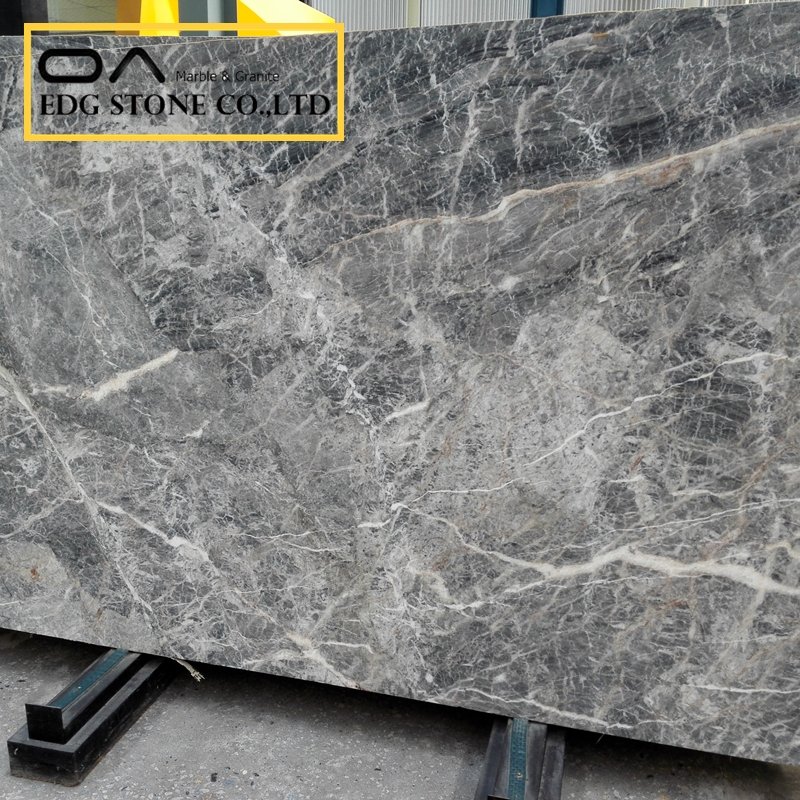
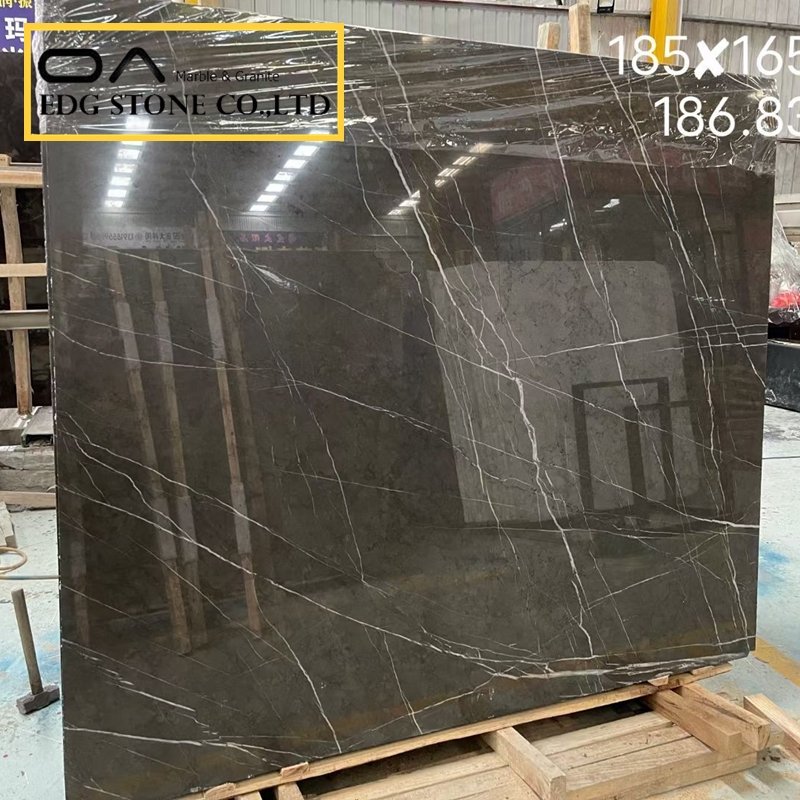
Part II: Beyond Grey: Understanding the Full Spectrum of Marble
Clarifying the Common Misconception of “Three Types of Marble”
Within the industry, marble is considered the only metamorphic rock formed from the metamorphosis of limestone.3 Therefore, the common search query asking for the “three types of marble” is often a terminological misunderstanding. It may refer to several different classification methods rather than a strict petrological classification.
First, it might refer to a classification by color: white (e.g., Carrara), black (e.g., Nero Marquina), and colored marbles (e.g., green or grey).10 Under this classification, grey marble falls into the “colored” category. Second, it might refer to famous Italian varieties categorized by
aesthetics or origin, such as Carrara, Calacatta, and Statuario.11 These varieties dominate the market due to their unique aesthetic features. Third, it might confuse “marble” with other metamorphic rock types, such as slate, schist, and gneiss.3 For consumers, understanding these classification methods is crucial, as it helps them more accurately describe the type of stone they are looking for.
By correcting this common misconception and providing a more accurate classification framework, the article not only answers the user’s practical question but also provides them with deeper industry knowledge. This explanatory approach turns a surface-level question into an educational opportunity, thus enhancing the content’s authority and usefulness.
The Rarest and Most Precious Marbles in the World
To provide a broader industry context, it is necessary to explore the rare and precious varieties in the world of marble. These stones are highly prized for their unique colors, textures, or scarcity.
Among all marbles, the rarest colors are typically blue, purple, and red.16 For example, the blue marble Azul Macaubas is known for its ethereal, sky- or deep-sea-like shades.16 The purple marble Calacatta Viola is a designer favorite for its creamy white background and rich violet veining.13 Red marble, like Rosso Levanto, makes a bold design statement with its fiery hues and dramatic appearance.
When referring to “precious” or “fancy” marbles, the term typically denotes varieties that are highly valued for their exceptional beauty, rarity, or historical significance. Portoro is a classic example, a black marble from Italy with rich gold and white veining. Its restricted quarrying and high extraction costs make it one of Italy’s rarest marbles.13 Other precious varieties include Statuario, known for its pristine white background and striking grey veins 13, Thassos White, hailed as “the whitest marble in the world” 10, and Calacatta Gold, with its valuable golden veining.
The reasons for the high cost of these rare and precious varieties are their limited production, difficult extraction, high global demand, and unique aesthetic value.13 They are typically used in the most luxurious projects, high-end residences, and artworks to showcase uniqueness and exceptional taste.
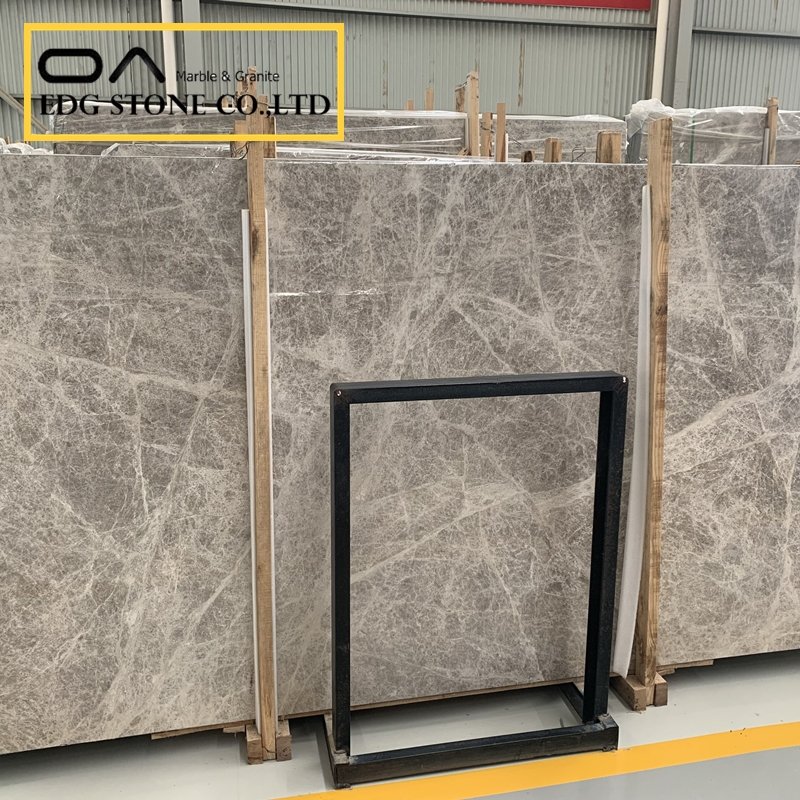
Part III: From Quarry to Countertop: The Commercial Side
The Stone’s Journey: Unveiling the Marble Supply Chain
From the quarry to the final countertop, the journey of marble is a complex four-step process.19 First, the marble is extracted from the quarry using techniques such as dynamite or modern wire saws.19 Next, the massive stones are cut into blocks, each weighing between 15,000 to 25,000 pounds.19 These blocks are then further cut into thin sheets, which we call slabs.19 Finally, the slabs are transported to a fabricator for final shaping and finishing to suit the needs of a specific project.
It is worth noting that modern technology is changing this process to make it more sustainable. For example, wire saw cutting technology is replacing traditional blasting because it significantly reduces noise, dust, and ground vibrations while producing cleaner cuts and less waste.
Buying Grey Marble: A Guide for Wholesale and B2B Buyers
For commercial buyers, understanding the global sources and supply chain of grey marble is crucial. Major marble production sites are found worldwide, with the most famous quarries located in Italy.19 However, many countries are known for specific grey marble varieties: Iran is renowned for Pietra Grey 2, Turkey for Tundra Grey and Hermes Grey 1, and Italy for varieties like Fior di Bosco and Grigio Carnico.
A key trend in international trade is the cross-continental processing of stone. While much marble is quarried in its country of origin, it is often shipped to other countries for processing and re-export. For example, research shows that the Asia-Pacific region, particularly China and India, dominates the global natural stone market.22 Many natural stones are exported from India to China, where they are processed and then re-exported from China to various parts of the world.22 For instance, despite Pietra Grey originating from Iran, many factories in China, Italy, and Turkey produce this stone.
This internationalized production and supply chain model means buyers need to be prudent in their choice of suppliers. Professional B2B platforms like StoneContact 15, LinkedIn 23, and attending international exhibitions 23 are all effective ways to find suppliers. Specialized manufacturers and suppliers such as Aravali Marbles 24 and HRST Stone 14 offer a one-stop solution for everything from slabs and blocks to tiles and various finishes.
Part IV: Industry Focus: Trends, Data, and Sustainability
Navigating the Natural Stone Market: Key Statistics and Trends
The global natural stone market is a thriving industry driven by several key trends. According to reports, the global market size was valued at USD 42.04 billion in 2024 25 and is expected to grow to USD 51.77 billion by 2029, with a compound annual growth rate (CAGR) of 4.3%.25 Another report shows the market was valued at USD 60.54 billion in 2024 and is projected to grow to USD 82.86 billion by 2032.
The main drivers of the market are an increase in construction projects, particularly the construction and renovation of high-end residential and commercial properties.22 The construction industry is the largest consumer of natural stone, holding a 68% market share.22 Additionally, consumer preferences are shifting towards unique, natural, and sustainable materials, which is another key factor driving industry growth.
Table 2: Key Natural Stone Market Statistics (2024-2034)
Metric | 2024 Valuation | 2029/2032/2034 Forecast | Growth Drivers |
Market Size | $42.04B / $60.54B | $51.77 (2029) / $82.86 (2032) / $51.77 (2034) | Growth in construction and renovation projects, shifts in consumer preferences, and demand from the luxury real estate sector |
CAGR | – | 4% – 4.3% | Global economic growth, infrastructure investment, cultural and artistic preferences |
Dominant Region | Asia-Pacific | Asia-Pacific (projected to continue its dominance and be the fastest-growing region) | Rapid urbanization, large-scale construction projects |
The Green Transition: Modern Regulations and Sustainable Quarrying
Although marble is a natural and sustainable building material that can be extracted directly from the ground and possesses exceptional durability and recyclability 21, its quarrying and processing have a significant environmental impact. The main negative effects include landscape alteration, dust emissions (especially inhalable particles PM2.5 and PM10) 20, disruption of groundwater systems 20, and the generation of significant waste (30% to 70% of the raw material can be turned into waste during processing).
To address these challenges and respond to increasingly strict regulations and consumer demand for sustainability, the marble industry is undergoing a “green transition.” This transition is not just about compliance; it is also a competitive advantage. Companies are actively embracing innovation and modernization, for example, by:
- Technological Innovation: Adopting computer-aided design and 3D modeling for precise planning to reduce waste.20 Using wire saw cutting technology instead of traditional blasting to reduce noise and dust.20 Using electric or hybrid vehicles to lower carbon emissions and noise pollution.21
- Resource Management: Implementing closed-loop water recycling systems to capture and filter water for reuse, thereby reducing water consumption and preventing contaminated runoff from entering natural waterways.20 Using natural and biodegradable glues and resins instead of harmful chemical products.21
- Quarry Rehabilitation: Reclaiming exhausted quarry sites and transforming them into land assets with ecological value.20 This includes carefully preserving topsoil, stabilizing slopes, and creating new ecosystems such as artificial lakes, wetlands, or nature reserves.
- Monitoring and Compliance: Using sophisticated environmental monitoring equipment to track air quality, water discharge, and noise levels in real time, and conducting regular environmental audits to ensure compliance with local, state, and federal regulations.
These advancements demonstrate that the modern natural stone industry is using regulations and consumer preferences as catalysts for innovation. By investing in sustainable technologies and practices, companies can not only meet regulatory requirements but also attract the modern consumer segment that seeks unique and eco-friendly materials, thereby distinguishing themselves in a competitive market.
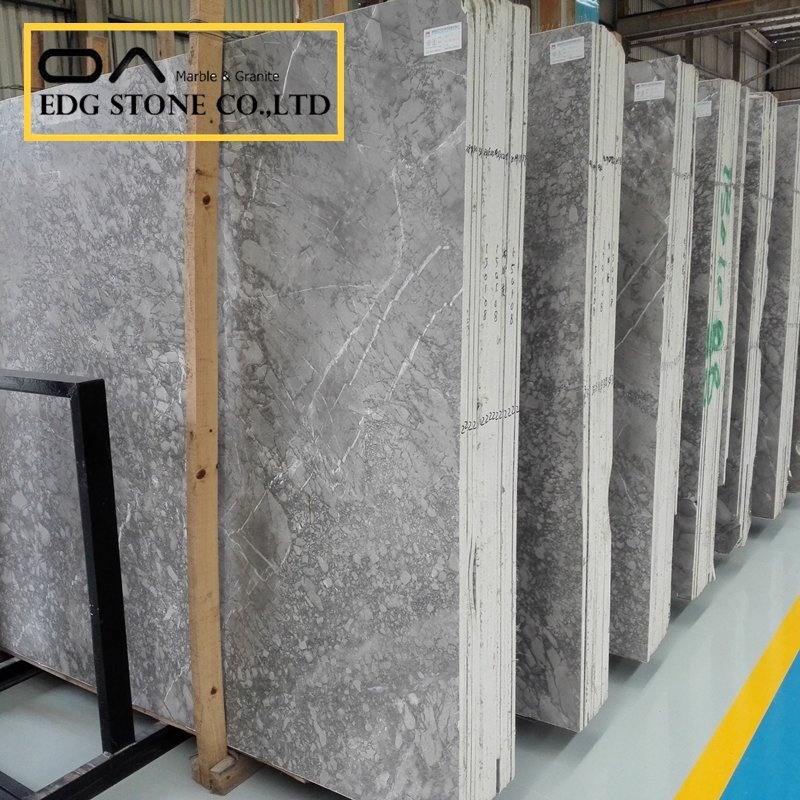
Part V: Practical Applications and Expert Care
Grey Marble Design: From Kitchens to Commercial Spaces
The versatility of grey marble allows it to perform exceptionally well in various design projects. It can seamlessly integrate into a wide range of styles, from minimalism to industrial.
- Kitchen Countertops: Grey marble is an ideal material for kitchen countertops, adding a sense of luxury and refinement to the space.2 A honed finish is particularly popular as it gives a kitchen island a chic, rustic flair.7
- Flooring and Walls: Grey marble tiles or slabs are commonly used for floors and walls in both residential and commercial spaces.5 They can create a calm, spa-like luxury atmosphere, especially for bathrooms.
- Fireplaces and Decor: Using grey marble around a fireplace can add subtle elegance or create a dramatic visual focal point through a richly veined variety.
Caring for Grey Marble: Best Maintenance Practices
Marble is a porous material, which means it is susceptible to liquid penetration, leading to stains, etching, and scratches.8 Therefore, proper maintenance is essential to preserve its beauty and durability.
Table 3: Marble Care and Maintenance Guide
Do’s | Don’ts |
Clean regularly: Use a pH-neutral cleaner or a solution of mild dish soap and water.29 Gently wipe the surface with a soft microfiber cloth.29 | Avoid acidic substances: Never use acidic cleaners like vinegar, lemon juice, citrus cleaners, bleach, or ammonia, as they will corrode the marble’s surface.28 |
Wipe spills immediately: Promptly wipe up any spills, especially substances like coffee, red wine, or fruit juice that can stain or etch the surface.27 | Avoid abrasive tools: Do not use hard-bristle brushes, scouring pads, or any abrasive tools, as they can scratch the marble surface.29 |
Seal regularly: Reseal the marble regularly (every 6-12 months for high-traffic areas) with a water-based sealant to prevent liquid from penetrating and causing stains.27 | Be mindful of heat: Avoid placing hot pots or pans directly on the marble surface.28 |
Take preventive measures: Use coasters, placemats, and cutting boards to create a protective layer between objects and the stone surface.28 | Neglect maintenance: Not cleaning or sealing regularly makes the marble more vulnerable to damage and stains.8 |
For stubborn stains, you can try applying a poultice made from baking soda and water and letting it sit for a while to draw the stain out.27 For stains on dark marble, acetone (found in most nail polish removers) is a good option.30 By following these simple maintenance guidelines, you can ensure the beauty and durability of your grey marble, allowing it to remain stunning for years to come.
Conclusion: The Enduring Legacy of Grey Marble
Grey marble, from its geological origins to its central role in modern design, is a fascinating case study that combines scientific, aesthetic, and commercial value. It is not a single stone but a family of rich varieties, each with its unique veining, color, and story. Its continued growth and popularity in the market are fueled by a global construction boom, increasing consumer preference for natural materials, and the industry’s continuous innovation in sustainability.
When you choose a grey marble for your next project, consider its diverse varieties, different finishes, and its place within a complex global supply chain. Also, understanding and committing to its proper care will ensure this powerful natural stone can stand the test of time, leaving a mark of timeless elegance in your space.

FAQ: Google Hot Search Q&A
Q1: What is the rarest color of marble?
A1: Although there are many rare varieties of marble, the rarest colors found in nature are blue, purple, and red. Famous examples include the blue marble Azul Macaubas, the purple marble Calacatta Viola, and the red marble Rosso Levanto.
Q2: What is a fancy marble called?
A2: Fancy or precious marbles are often named for their unique beauty, rarity, or historical significance. Highly prized varieties include Statuario, Calacatta, and the intensely veined Portoro marble.
Q3: What are the pros and cons of grey marble flooring?
A3: The main advantage of grey marble flooring is its luxurious and elegant appearance, which can add value to a home. The disadvantages include its porous nature, which makes it susceptible to stains and scratches, and the need for regular sealing and specialized maintenance.
Q4: How do you clean grey marble?
A4: It is recommended to clean grey marble with a pH-neutral cleaner or a solution of mild dish soap and water. Wipe with a soft cloth and clean up spills immediately. Never use acidic cleaners like vinegar or lemon juice, as they will corrode the stone’s surface.
Q5: What is the best grey marble for kitchen countertops?
A5: The best choice depends on personal style, but popular options include Pietra Grey for a deep, dramatic look or Tundra Grey for a softer, more neutral tone. A honed or leathered finish is often preferred as it helps reduce visible fingerprints and scratches.
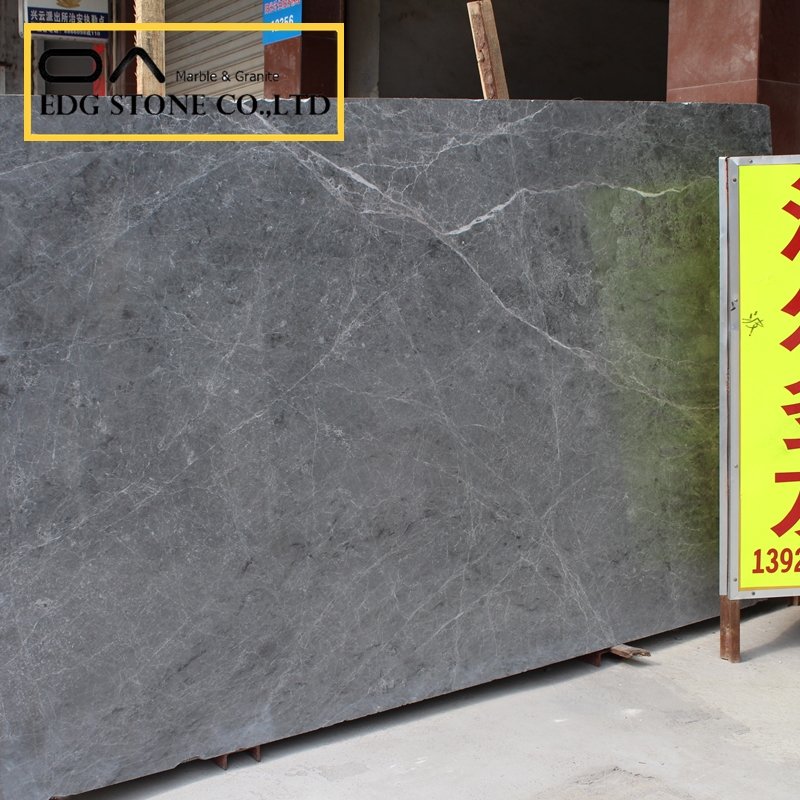
Unlocking the Value of Grey Marble in Modern Design and Industry
What is grey marble? Grey marble is not a single stone but a family of metamorphic rocks whose tones and veining range from light silver to deep charcoal. Its unique aesthetic features are determined by geological impurities during its formation and are further enhanced through various surface finishes.
Why is grey marble so popular? Its versatile tones and timeless elegance make it a staple in modern design, capable of seamlessly fitting into various styles. Its popularity is fueled by a global construction and renovation boom and the growing consumer preference for natural materials.
How is the grey marble industry evolving? The industry is transitioning towards sustainability by adopting advanced technologies (such as wire saw cutting and closed-loop water systems) to minimize its environmental impact. This innovation, combined with a complex global supply chain, is shaping a more responsible and efficient market.
Key considerations: When selecting grey marble, it’s crucial to consider the variety’s origin, veining, and surface finish. For long-term use, you must understand its porosity and adhere to proper maintenance, such as using pH-neutral cleaners and regular sealing, to preserve its beauty and durability.
SEO Tags:
gGreymarble types, what are the different types of grey marble, grey marble names, what color is marble gray, gray marble countertop, gray marble flooring, pietra grey marble, tundra grey marble, fior di bosco marble, grey emperador marble, hermes grey marble, grigio carnico, picasso grey marble, what are the three types of marble, what is the rarest color of marble, fancy marble names, luxury marble, natural stone market, marble industry trends, sustainable marble quarrying, how to clean marble, marble maintenance tips, wholesale grey marble, grey marble manufacturer, marble factory, how to buy marble, marble supply chain, marble slab vs tile, honed vs polished marble, kitchen countertops marble, bathroom marble design, marble care guide, marble porosity, calacatta marble, statuario marble, marble stone types, black and white marble, marble price per sq ft, marble vs granite, marble quarries, industrial design marble, minimalist design marble, modern marble trends, marble vs engineered stone, marble for sale, grey marble suppliers, grey marble exporter, marble blocks wholesale, marble environmental impact.
